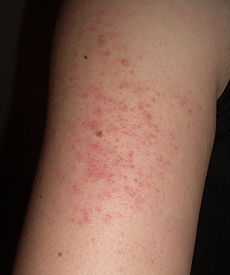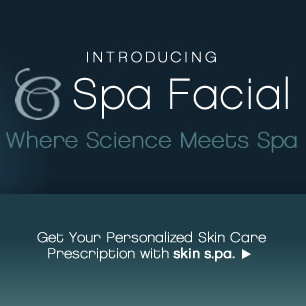Keratosis Pilaris, and the boy who had chicken skin
I’d love to tell you the story of a boy who has chicken skin, and how he manages this skin condition doctors call Keratosis Pilaris.
He was born with the condition, and his mom noticed it when he was about 4 months old. The pediatrician insisted that most babies get occasional little white pimples and it would go away. But it didn’t.
The condition seemed to get worse and worse. The boy also tended to get very red and hot in the face when he went outside with other kids. His arms were very rough and pimply, and the skin almost looked as if it came from a newly plucked chicken. The mom consulted the pediatrician multiple times, with the same answer….it’ll go away on its own. But it didn’t.
pimply, and the skin almost looked as if it came from a newly plucked chicken. The mom consulted the pediatrician multiple times, with the same answer….it’ll go away on its own. But it didn’t.
One day, the mom noticed one of the pimples getting really large and almost looked like a real white head. When the boy scratched it, it popped. The mom knew this wasn’t just in her head, this was a real skin condition that needed to be treated. When she started talking to other members of her extended family, she found out that other people in her family had it too. She searched the internet and found a lone article about a girl who had this condition and always called it chicken skin. The dermatologist had diagnosed it as Keratosis Pilaris.
By this time, the mom had changed pediatricians for other reason and asked the new pediatrician if it could be Keratosis Pilaris and the pediatrician agreed! Now she had a name for the condition, so what is it? The skin is a fabulous organ made of a whole host of things including elastin, melanin, collagen and keratin. It turns out that Keratosis Pilaris (KP for short) is the buildup of keratin that traps the hair follicle under the skin.
Keratosis Pilaris is a skin condition that has no cure, but it shouldn’t cause an issue if treated. Most of the time, the worst that can happen is that an entrapped hair follicle can become inflamed, almost like a white head. But on some occasions, the hair follicle can also become infected and require antibiotics. Most of the treatments are quite simple: exfoliation, hydrocortisone cream for the redness, and lactic acid to break down the keratin buildup.
So now that you know the boy’s story, I’ll tell you that the boy is my own son. We have tried most of the mainstream treatments and I can honestly say that chemical peel and dermabrasion (exfoliation) works best for him. We’ve tried the lactic acid and urea creams, but it’s hard to remember to put the cream on multiple times a day. It also makes him more sensitive to sunlight, so that’s not an option in the summer. Since we only have to do the exfoliation once or twice a week, we don’t have to remember to send it with him when he sleeps over someone’s house or goes to day camp.
So now you know his story and I hope this helps you in dealing with this skin condition. Lots of love, and have a spectacular day!
Christine
Related Articles
Trackbacks
- The Difference Between Common Skin Ailments | Mobile Spa Squad
- Treating eczema « Primitive Moon Health & Lifestyle Blog
- Why Do You Still Have Rosacea? It Might Be Your Skin Regimen. « Primitive Moon Health & Lifestyle Blog
- What is Eczema? « PMICreations Spa Blog
- The Difference Between Common Skin Ailments « PMICreations Spa Blog





You may really feel some dryness and also flaking to get a couple of days right after a microdermabrasion remedy,
but some at house moisturizers can assist with this.
Should you are a very first timer, you could want to commence off with two remedies a month for a handful of months,
then numerous men and women go down to just 1 treatment a month.
Hi, nice site but occasionally I see a problem whereby the top navigation toolbar can’t be seen. It is mainly on the default webpage Cheers
It is extremely interesting for me to read that blog. Thanks for it. I like such topics and everything connected to this matter. I definitely want to read more on that blog soon.
Sara Kripke
It is certainly interesting for me to read the blog. Thanx for it. I like such topics and everything connected to them. I definitely want to read a bit more soon.
Mary Pingtown
It is extremely interesting for me to read that blog. Thanx for it. I like such themes and anything that is connected to this matter. I would like to read more soon.
Julia Kuree
Can’t thank you enough for posting this.
I have been plagued by KP my whole life. It’s hereditary too, my mom had it, my daughter now has it. Just one of those lovely genes that get’s passed along and it out there in the open for kids to pick on you about. Even today as an adult I get the occassional “what’s wrong with the skin on your arms”, from both people I know and from total strangers.
I saw a dermatologist when I was a teen, and his uneducated answer was, “you’re not getting clean enough, scrub more”. What those who don’t understand the skin disrder don’t know is you can scrub until the skin is raw, it does not make the skin disorder go away.
Several years ago as an adult, I had to see a different dermatologist to have a mole removed from my face. As soon as the doctor walked in and saw me for the 1st time, the first words out of her mouth were “what are you doing about your KP?”.
I did not have a clue what she was talking about, then she described the condition. Like you described in your post, it’s a defect in the skin pour where the keratin and protein build up. There are different severity’s of it, it can clog pours, turn into white heads, or you can have normal hair growth and the protein & keratin in the pour will continue to build, all of the above. There are different extreems to the condition. The body normally sluff’s off this skin on it’s own, but for those with KP, the body does not properly do this, and it remains trapped resulting in the bumps or “chicken skin” look.
She perscribed a highly expensive regimine of salic acid products, which I used for a couple of weeks and just could not take any more. It was not overly effective, it has long term consiquence of damaging the skin, and left the skin with a residue and greasy feelng. Further, she mentioned that the skin after months of use, will become tollerant and the product will stop being effective, so they would have to move to something harsher or stronger.
The good thing about the dermatologist is that she took the time to explain the condition, why scrubbing alone is not the answer, she explained that the skin actually needs a chemical to remove the keratin and potein buildup.
I am so excited to read that BC’s products have worked on your son and will try them tonight on my arms. It would be easier and less expensive than the perscription strengthy products the dermatologist had perscribed, and less maintence to keep up with.
I’ll take pictures of the before and after too, to monitor the results.
I have what they diagnosed as very severe KP. It’s on all of my arms, thighs, calfs, back, belly and neck. The only place I have not been plagued with it is on my face, which I’m told is normal since the skin on the face is different than other parts of the body.
My daughter appears to have it only on her arms and back, and luckly her’s is not as noticeable as mine.
I’ll keep you posted on how the products work on someone with VERY severe KP, like me.
I have KP on my neck too. What have you found that works in that area? Does yours itch?
So, a common question I’ve been getting is how to tell the difference between other skin ailments and KP. The first one was rosacea. Sometimes KP resembles rosacea and is improperly treated. It’s also sometimes misdiagnosed as acne and treated with acne products, which can make KP flare up. And last but not least, KP can sometimes resemble eczema on the arms or legs. Eczema treatment will not hurt KP, but will definitely not help either. Since I’ve had experience (either personally or with clients) with all of these conditions, I’ll write a post early next week with pictures to help you in this area. Stay tuned!